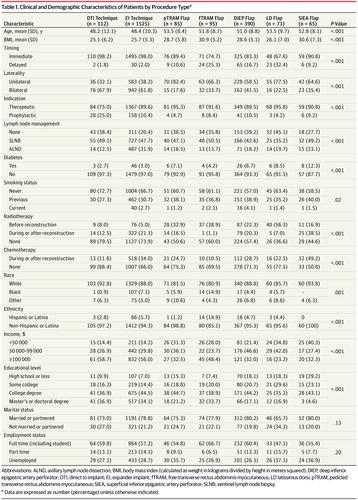JAMA Surgery ( IF 15.7 ) Pub Date : 2018-10-01 , DOI: 10.1001/jamasurg.2018.1687 Katelyn G. Bennett 1 , Ji Qi 1 , Hyungjin M. Kim 2, 3 , Jennifer B. Hamill 1 , Andrea L. Pusic 4 , Edwin G. Wilkins 1

|
Importance In breast reconstruction, it is critical for patients and surgeons to have comprehensive information on the relative risks of the available options. However, previous studies that evaluated complications were limited by single-center designs, inadequate follow-up, and confounding.
Objective To assess 2-year complication rates across common techniques for postmastectomy reconstruction in a multicenter patient population.
Design, Setting, and Participants This longitudinal, multicenter, prospective cohort study conducted from February 1, 2012, through July 31, 2015, took place at the 11 study sites associated with the Mastectomy Reconstruction Outcomes Consortium study. Eligible patients included women 18 years and older presenting for first-time breast reconstruction with at least 2 years of follow-up. Procedures evaluated included direct-to-implant (DTI) technique, expander-implant (EI) technique, latissimus dorsi (LD) flap, pedicled transverse rectus abdominis myocutaneous (pTRAM) flap, free transverse rectus abdominis myocutaneous (fTRAM) flap, deep inferior epigastric perforator (DIEP) flap, and superficial inferior epigastric artery (SIEA) flap.
Interventions Postmastectomy breast reconstruction.
Main Outcomes and Measures Development of complications, reoperative complications, and wound infections during 2-year follow-up. Mixed-effects logistic regression analysis controlled for variability among centers and for demographic and clinical variables.
Results A total of 2343 patients (mean [SD] age, 49.5 [10.1] years; mean [SD] body mass index, 26.6 [5.7]) met the inclusion criteria. A total of 1525 patients (65.1%) underwent EI reconstruction, with 112 (4.8%) receiving DTI reconstruction, 85 (3.6%) pTRAM flaps, 95 (4.1%) fTRAM flaps, 390 (16.6%) DIEP flaps, 71 (3.0%) LD flaps, and 65 (2.8%) SIEA flaps. Overall, complications were noted in 771 (32.9%), with reoperative complications in 453 (19.3%) and wound infections in 230 (9.8%). Two years postoperatively, patients undergoing any autologous reconstruction type had significantly higher odds of developing any complication compared with those undergoing EI reconstruction (pTRAM flap: odds ratio [OR], 1.91; 95% CI, 1.10-3.31; P = .02; fTRAM flap: OR, 2.05; 95% CI, 1.24-3.40; P = .005; DIEP flap: OR, 1.97; 95% CI, 1.41-2.76; P < .001; LD flaps: OR, 1.87; 95% CI, 1.03-3.40; P = .04; SIEA flap: OR, 4.71; 95% CI, 2.32-9.54; P < .001). With the exception of LD flap reconstructions, all flap procedures were associated with higher odds of reoperative complications (pTRAM flap: OR, 2.48; 95% CI, 1.33-4.64; P = .005; fTRAM flap: OR, 3.02; 95% CI, 1.73-5.29; P < .001; DIEP flap: OR, 2.76; 95% CI, 1.87-4.07; P < .001; SIEA flap: OR, 2.62; 95% CI, 1.24-5.53; P = .01) compared with EI techniques. Of the autologous reconstructions, only patients undergoing DIEP flaps had significantly lower odds of infection compared with those undergoing EI procedures (OR, 0.45; 95% CI, 0.25-0.29; P = .006). However, DTI and EI procedures had higher failure rates (EI and DTI techniques, 7.1%; pTRAM flap, 1.2%; fTRAM flap, 2.1%; DIEP flap, 1.3%; LD flap, 2.8%; and SIEA flap, 0%; P < .001).
Conclusions and Relevance Significant differences were noted across reconstructive procedure types for overall and reoperative complications, which is critically important information for women and surgeons making breast reconstruction decisions.
中文翻译:

乳房切除术后乳房重建常用技术中2年并发症发生率的比较
在乳房重建中的重要性,对于患者和外科医生而言,获得有关可用选项的相对风险的全面信息至关重要。但是,以前评估并发症的研究受到单中心设计,随访不足和混淆的限制。
目的 评估多中心患者人群乳房切除术后重建常用技术的2年并发症发生率。
设计,背景和参与者 这项于2012年2月1日至2015年7月31日进行的纵向,多中心,前瞻性队列研究在与乳房切除术重建结果联合会研究相关的11个研究地点进行。符合条件的患者包括18岁以上首次进行乳房再造且至少随访2年的女性。评估的程序包括直接植入(DTI)技术,扩张器-植入(EI)技术,背阔肌(LD)皮瓣,带蒂腹直肌腹肌皮(pTRAM)皮瓣,腹直肌腹直肌肌皮(fTRAM)皮瓣,深深下上腹穿孔器(DIEP)皮瓣和浅表下腹动脉(SIEA)皮瓣。
干预 乳房切除术后乳房重建。
主要结果和措施 在两年的随访中发现并发症,手术并发症和伤口感染的发生。混合效应逻辑回归分析控制了中心之间的变异性以及人口统计和临床变量。
结果 共有2343例患者(平均[SD]年龄为49.5 [10.1]岁;平均[SD]体重指数为26.6 [5.7])符合纳入标准。共有1525例患者(65.1%)进行了EI重建,其中112例(4.8%)接受了DTI重建,85例(3.6%)pTRAM皮瓣,95例(4.1%)fTRAM皮瓣,390例(16.6%)DIEP皮瓣,71例(3.0) %)LD襟翼和65(2.8%)SIEA襟翼。总体而言,有771例(32.9%)被发现有并发症,其中453例(19.3%)出现了手术并发症,而230例(9.8%)出现了伤口感染。术后两年,与进行EI重建的患者相比,进行任何自体重建类型的患者发生并发症的几率明显更高(pTRAM瓣片:优势比[OR]为1.91; 95%CI为1.10-3.31;P = .02; fTRAM瓣:或,2.05; 95%CI,1.24-3.40; P = .005; DIEP瓣:或,1.97;95%CI,1.41-2.76;P <0.001;LD襟翼:或为1.87;95%CI,1.03-3.40;P = .04;SIEA襟翼:或,4.71;95%CI,2.32-9.54; P <.001)。除LD皮瓣重建外,所有皮瓣手术均与更高的手术并发症发生率相关(pTRAM皮瓣:OR,2.48; 95%CI,1.33-4.64; P = .005; fTRAM皮瓣:OR,3.02; 95%CI ,1.73-5.29; P <.001; DIEP瓣:或,2.76; 95%CI,1.87-4.07; P <.001; SIEA瓣:或,2.62; 95%CI,1.24-5.53; P = .01)与EI技术相比。在自体重建中,只有接受DIEP皮瓣的患者与接受EI手术的患者相比,感染几率显着降低(OR,0.45; 95%CI,0.25-0.29;P = .006 )。但是,DTI和EI手术的失败率更高(EI和DTI技术为7.1%; pTRAM皮瓣为1.2%; fTRAM皮瓣为2.1%; DIEP皮瓣为1.3%; LD皮瓣为2.8%; SIEA皮瓣为0%。P <.001)。
结论和相关性 注意到在整个和手术并发症的重建程序类型之间存在显着差异,这对于女性和外科医生做出乳房重建决策至关重要。











































 京公网安备 11010802027423号
京公网安备 11010802027423号